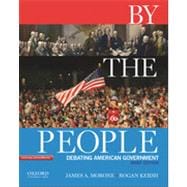Challenge your students to ENGAGE in the conversation and process; THINK about the ideas, history, structure, and function; and DEBATE the merits of American government and politics in the 21st century.
In a storytelling approach that weaves contemporary examples together with historical context, By the People: Debating American Government, Brief Edition, explores the themes and ideas that drive the great debates in American government and politics. It introduces students to big questions like Who governs? How does our system of government work? What does government do? and Who are we? By challenging students with these questions, the text gets them to think about, engage with, and debate the merits of U.S. government and politics.
Ideal for professors who prefer a shorter text, By the People, Brief Edition, condenses the content of the comprehensive edition while also preserving its essential insights, organization, and approach. Approximately 20% shorter and less expensive than its parent text, the full-color Brief Edition features a more streamlined narrative, deletes the "Comparing Nations" boxes, and is enhanced by the same extensive support package as the longer edition.
FEATURES:
ENGAGE
* "By the Numbers" boxes containing fun facts help frame the quizzical reality of American politics and government
* "See For Yourself" features enable students to connect with the click of a smart phone to videos and other interactive online content
THINK
* Chapter One introduces students to seven key American ideas, which are revisited throughout the text
* "The Bottom Line" summaries conclude each chapter section, underscoring the most important aspects of the discussion
DEBATE
* "What Do You Think?" boxes encourage students to use their critical-thinking skills and debate and/or take a stand on important issues
* Four major themes, in the form of questions to spark debate, are presented to students in Chapter One and appear throughout the text








